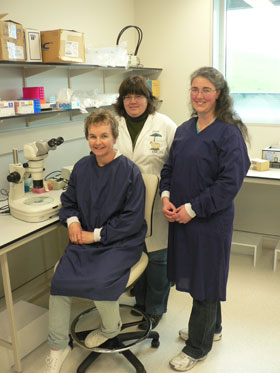 L-R: Karen Reader, Dr Jenny Juengel, Dr Jo-Ann Stanton
L-R: Karen Reader, Dr Jenny Juengel, Dr Jo-Ann Stanton
Mysterious and little-studied structures within sheep oocytes have caught PhD student Karen Reader's eye through the microscope.
Karen is based at The Centre for Reproduction and Genomics' purpose-built facility at Invermay, where her work and study have come together under one roof. Increasing lambing productivity has always been a core focus for AgResearch's Animals group, which Karen has worked with for more than 10 years. During this time she has seen a major shift towards embryo survival and oocyte quality, where the answer could lie to boosting lambing rates.
Karen's thesis, supervised by Dr Jo-Ann Stanton of the Department of Anatomy and Structural Biology and Dr Jenny Juengel of AgResearch, aims to find out why younger ewes are less fertile despite the fact they have reached sexual maturity. She is comparing the internal structure of oocyte (egg) samples from lambs and ewes, and using electron microscopy to see how embryo production changes over an animal's lifetime.
Although there are several possible research methods, both on-farm and in the lab, Karen's quantitative ultrastructure study is uncovering some interesting details with the help of the Otago Centre for Electron Microscopy.
Karen initially suspected mitochondria could be the greatest area of interest but is now looking further at storage vesicles, organelles that provide nutrients to support the growth of the embryo after fertilisation. Although the role of vesicles hadn't previously been considered in great detail, Karen's initial results showed that the volume present in the oocyte is reduced in the lambs.
Future work will involve whole transcriptome sequencing at the university to look for genes differentially expressed between the less competent lamb oocytes and the adults.
“There are so many genes of interest and so many possible pathways, but I am taking the ultra-structural approach to narrow down the search.”
The next stage is to identify the contents of the vesicles and find ways of altering their volume in vitro using hormones or nutrients. If the difference in vesicle volume proves to be related to fertility, and in particular, proves to be controllable, there could be some real farm impacts and significant benefits for farmers.
“It will increase the lifetime of productivity if you can breed ewes earlier. In addition, any improvements to in-vitro embryo production methods could help to speed up genetic gain in livestock.”